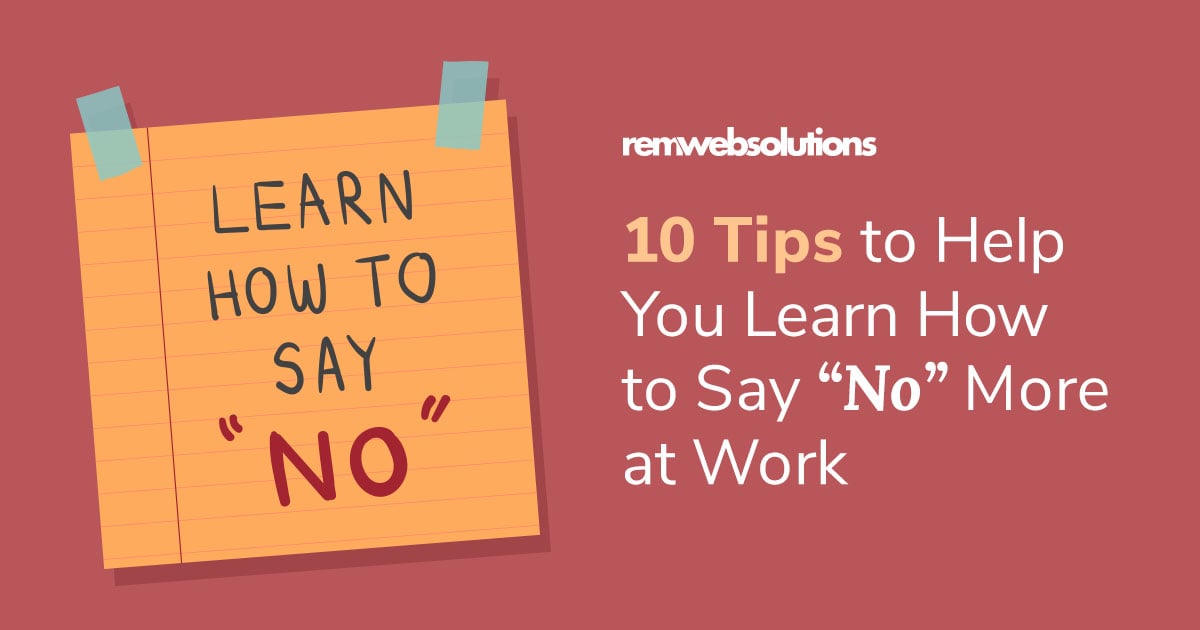
Being a people pleaser may seem like a positive trait, but it can also come with downsides. People pleasers often have trouble saying “no,” and as a result, end up doing more than they have the time or capacity for.
Although it’s valuable to help your co-workers and employees when they need it, it isn’t worth going beyond your personal limits until you’re left with little energy to focus on your own tasks. Learning to say no when you need to can be difficult when you’re a people-pleaser, but there are ways you can start setting more boundaries in the workplace.
Try some of these tips below.
1. Be polite but firm
If someone approaches you with a task that you know you won’t be able to do, you don’t need to immediately resort to giving a defensive or harsh “no” as a response to make the other person back down. Be polite but make it clear to the person you’re speaking with that your answer is firm and does not leave any unnecessary room for debate.
When in doubt, keep it simple and to the point. A basic “I’m sorry, but I won’t be able to do that right now,” is typically the perfect way to approach a request that you don’t want or have the time to take on. Most people will be able to understand and respect your decision if you’re clear and unshakable from the start.
2. Don’t always feel the need to justify your “no”
It can be challenging for people-pleasers to not immediately resort to giving longwinded justifications when they turn down a request at work. Although it can be helpful to provide context to some queries that are brought to your attention, specifically for larger, more complicated tasks, it isn’t always necessary.
For smaller requests specifically, don’t go out of your way to give a long list of excuses as to why you can’t do something. Sometimes, a straightforward “no” is all you need to put a personal boundary in place at work.
3. Prioritize time for yourself
If you notice that you’re starting to feel exceedingly overwhelmed and are finding it difficult to manage your day-to-day tasks, consider prioritizing time for yourself. You’re more prone to end up in uncomfortable situations or feeling burnt out at work when you’re not focusing on your own needs and putting your co-workers’ desires ahead your own.
If you take the time to focus on your mental health and overall wellbeing, you will likely feel more capable and confident to tackle the requests that come your way. Saying “no” won’t feel as difficult or guilt-inducing, and you may want to freely say “yes” more often if you can manage your time more effectively.
4. Take time to think about it
It can be an easy habit to slip into when you want to keep everyone around you happy and pleased with your work performance but saying “yes” immediately to every person who asks you to do something is not always a smart move. And the same can be said for saying “no” right away to certain requests as well.
There’s no harm in taking some time to think about what’s being asked of you. Ask yourself some questions, especially if what the person is requesting isn’t a simple task:
- Do I really have the proper amount of time to dedicate to this?
- Is this going to take time away from my own to-do list?
- Am I doing this because I genuinely want to, or because saying “no” would make me feel guilty?
- Does this person genuinely need my help and is just asking for a favour, or are they taking advantage of my willingness to assist them?
If you make a point to ask yourself these questions when someone wants you to do something for them, it will help you reach a reasonable conclusion that won’t leave you regretting your answer later. So, the next time a co-worker comes to you with a request, consider responding with something like this: “I will think about it and get back to you by the end of the day.”
5. Acknowledge the other side
As you learn how to say “no” more, don’t forget to remain as empathetic and compassionate as possible. You don’t want to needlessly step on any toes and negatively impact your workplace relationships unintentionally. Acknowledge the other person’s perspective and try to express that you understand where they’re coming from.
While this step is not necessary for every instance of saying “no,” it can be helpful for specific situations where a kinder approach is needed. Even something as simple as stating “I know that this is not the answer you were hoping for” can help lessen the potential blow of turning down the task that’s being asked.
6. Adjust your own expectations
Sometimes, even if you do everything “right” and approach these situations with nuance and graciousness, people may still respond negatively. It is important to recognize that many people will not always react positively when they hear ‘no’ and it may have nothing to do with you at all. Try not to look too much into an unfavorable response from a help-seeker or take it personally. More often than not, they’re likely just frustrated, and their reaction has little to do with you at all.
It’s far more constructive and beneficial to set any needed boundaries instead of going against your limits to appease others out of fear that they won’t like you. Handling rejection is a part of life, especially at work, and you can’t always control how people react to it, even if you do everything you can to lessen the blow from the refusal.
7. Practice as much as you can
You won’t be able to turn down requests well if you don’t get yourself used to doing it. Even if it seems silly, take the time to practice saying “no” out loud. Try talking out hypothetical scenarios to yourself behind closed doors, or even work on it with a friend or trusted colleague.
This can help you work on your tone and your initial reaction. After all, like most other communication skills, learning to say no needs practice and can be refined over time if you do your best to improve it.
8. Compromise or propose an alternative
Although this option is not always a necessary, it can be useful to offer a compromise or propose an alternative instead of ending a proposal with a simple “no.” Ask the person if there are other small ways you can be helpful in that specific situation, suggest a brainstorming session with them later, or mention a better time they could approach you with the request.
If you offer someone a lifeline, it will convey an attitude that indicates you still care about them and their needs, while not completely giving in and letting go of your own boundaries.
9. Be authentic and honest
Most people can tell if you’re forcing out a fake response or coming up with a lie on the spot to get out of something you don’t want to do. While you don’t always owe someone a detailed response when you’re not able to do a task for them, it can be a polite courtesy to give a brief explanation as to why you are not able to help that person out.
It can be useful for them as much as it is for you. They may gain a perspective they had never considered before, which may positively affect how they approach you with similar requests in the future. Sincerity is far more likely to guide a situation to an agreeable conclusion than dishonesty.
10. Recognize your limits
Similarly to the importance of prioritizing time for yourself, it’s essential to recognize your personal limits. Consider saying “yes” to one or two people for smaller tasks but turn down any additional requests you receive that week or people coming to you with larger projects that you know you won’t have time for if you agree to do them.
Once you begin to acknowledge your own limitations instead of instinctively taking on every request that’s brought to you, you will be able to properly recognize when you’re able to help others without sacrificing your health or performance in the process.
Remember:
Do:
- Be polite and offer alternatives when the situation requires it.
- Critically think about if you have the time and/or the mental bandwidth to dedicate to the request that’s being asked of you.
- Practice saying no out loud – it will eventually become easier the more you do it.
Don’t:
- Be rude or use a hesitant tone when you respond.
- Feel the need to lie or give excessive, drawn-out excuses that are insincere.
- Tiptoe around your true feelings in order to keep the other person happy. Stand your ground while being honest and respectful.
Conclusion:
Saying “no” can be a hard thing to do for people who are used to taking on every request – no matter what the consequences are for their personal limits and schedules. If you start to apply these tips, turning down help-seekers won’t be so difficult when you need to prioritize yourself.























